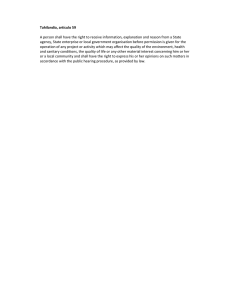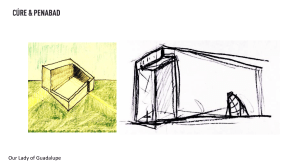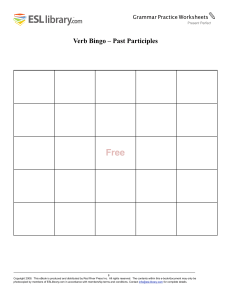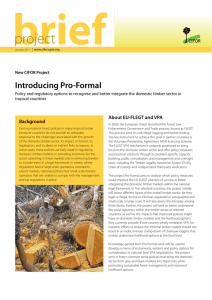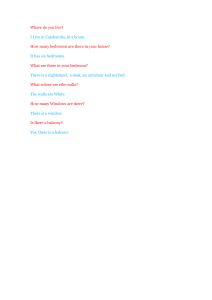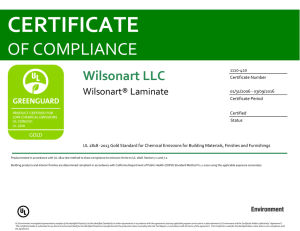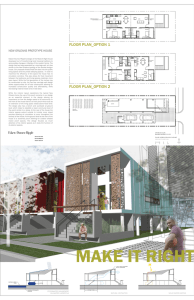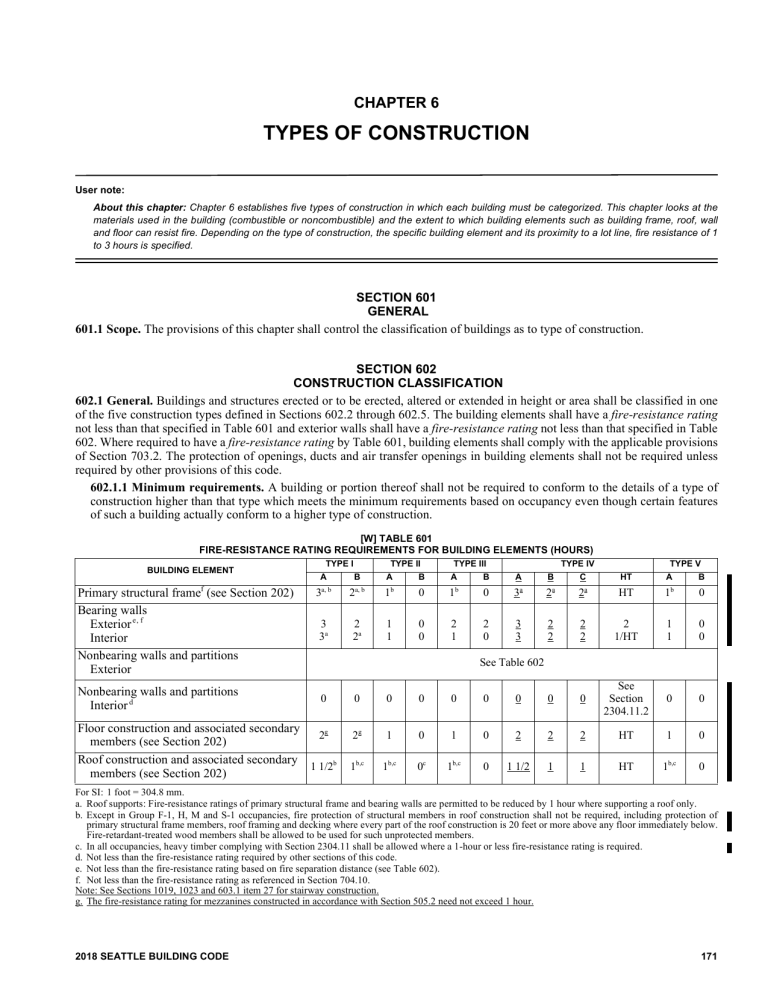
CHAPTER 6 TYPES OF CONSTRUCTION User note: About this chapter: Chapter 6 establishes five types of construction in which each building must be categorized. This chapter looks at the materials used in the building (combustible or noncombustible) and the extent to which building elements such as building frame, roof, wall and floor can resist fire. Depending on the type of construction, the specific building element and its proximity to a lot line, fire resistance of 1 to 3 hours is specified. SECTION 601 GENERAL 601.1 Scope. The provisions of this chapter shall control the classification of buildings as to type of construction. SECTION 602 CONSTRUCTION CLASSIFICATION 602.1 General. Buildings and structures erected or to be erected, altered or extended in height or area shall be classified in one of the five construction types defined in Sections 602.2 through 602.5. The building elements shall have a fire-resistance rating not less than that specified in Table 601 and exterior walls shall have a fire-resistance rating not less than that specified in Table 602. Where required to have a fire-resistance rating by Table 601, building elements shall comply with the applicable provisions of Section 703.2. The protection of openings, ducts and air transfer openings in building elements shall not be required unless required by other provisions of this code. 602.1.1 Minimum requirements. A building or portion thereof shall not be required to conform to the details of a type of construction higher than that type which meets the minimum requirements based on occupancy even though certain features of such a building actually conform to a higher type of construction. [W] TABLE 601 FIRE-RESISTANCE RATING REQUIREMENTS FOR BUILDING ELEMENTS (HOURS) BUILDING ELEMENT Primary structural framef (see Section 202) Bearing walls Exterior e, f Interior Nonbearing walls and partitions Exterior Nonbearing walls and partitions Interior d TYPE I TYPE II TYPE III TYPE IV TYPE V A B A B A B A B C HT A B 3a, b 2a, b 1b 0 1b 0 3a 2a 2a HT 1b 0 3 3a 2 2a 1 1 0 0 2 1 2 0 3 3 2 2 2 2 2 1/HT 1 1 0 0 See Table 602 0 Floor construction and associated secondary 2g members (see Section 202) Roof construction and associated secondary 1 1/2b members (see Section 202) 0 0 0 0 0 0 0 0 See Section 2304.11.2 0 0 2g 1 0 1 0 2 2 2 HT 1 0 1b,c 1b,c 0c 1b,c 0 1 1/2 1 1 HT 1b,c 0 For SI: 1 foot = 304.8 mm. a. Roof supports: Fire-resistance ratings of primary structural frame and bearing walls are permitted to be reduced by 1 hour where supporting a roof only. b. Except in Group F-1, H, M and S-1 occupancies, fire protection of structural members in roof construction shall not be required, including protection of primary structural frame members, roof framing and decking where every part of the roof construction is 20 feet or more above any floor immediately below. Fire-retardant-treated wood members shall be allowed to be used for such unprotected members. c. In all occupancies, heavy timber complying with Section 2304.11 shall be allowed where a 1-hour or less fire-resistance rating is required. d. Not less than the fire-resistance rating required by other sections of this code. e. Not less than the fire-resistance rating based on fire separation distance (see Table 602). f. Not less than the fire-resistance rating as referenced in Section 704.10. Note: See Sections 1019, 1023 and 603.1 item 27 for stairway construction. g. The fire-resistance rating for mezzanines constructed in accordance with Section 505.2 need not exceed 1 hour. 2018 SEATTLE BUILDING CODE 171 TYPES OF CONSTRUCTION [W] TABLE 602 FIRE-RESISTANCE RATING REQUIREMENTS FOR EXTERIOR WALLS BASED ON FIRE SEPARATION DISTANCEa, d, g, j FIRE SEPARATION DISTANCE = X (feet) TYPE OF CONSTRUCTION OCCUPANCY GROUP He OCCUPANCY GROUP F-1, M, S-1f OCCUPANCY GROUP A, B, E, F-2, I, Ri, S-2, Uh X < 5b All IA, IVA, Others IA, IB, IVA, IVB, IIB, VB Others All 3 3 2 2 1 1 0 2 2 1 1 0 1 0 1 1 1 1c 0 1c 0 5 ≤ X < 10 10 ≤ X < 30 X ≥ 30 For SI: 1 foot = 304.8 mm. a. Load-bearing exterior walls shall also comply with the fire-resistance rating requirements of Table 601. b. See Section 706.1.1 for party walls. c. Open parking garages complying with Section 406 shall not be required to have a fire-resistance rating. d. The fire-resistance rating of an exterior wall is determined based upon the fire separation distance of the exterior wall and the story in which the wall is located. e. For special requirements for Group H occupancies, see Section 415.6. f. For special requirements for Group S aircraft hangars, see Section 412.3.1. g. Where Table 705.8 permits nonbearing exterior walls with unlimited area of unprotected openings, the required fire-resistance rating for the exterior walls is 0 hours. h. For a building containing only a Group U occupancy private garage or carport, the exterior wall shall not be required to have a fire-resistance rating where the fire separation distance is 5 feet (1523 mm) or greater. i. For a Group R-3 building of Type II-B or Type V-B construction, the exterior wall shall not be required to have a fire-resistance rating where the fire separation distance is 5 feet (1523 mm) or greater. j. Existing buildings may encroach a maximum of 4 inches into the required fire separation distance, solely for the purpose of adding insulation to the building exterior. 602.2 Types I and II. Types I and II construction are those types of construction in which the building elements listed in Table 601 are of noncombustible materials, except as permitted in Section 603 and elsewhere in this code. 602.3 Type III. Type III construction is that type of construction in which the exterior walls are of noncombustible materials and the interior building elements are of any material permitted by this code. Fire-retardant-treated wood framing and sheathing complying with Section 2303.2 shall be permitted within exterior wall assemblies of a 2-hour rating or less. Interpretation I602.3: Type IIIA buildings are permitted to include exposed heavy-timber construction for columns, beams, girders, arches, trusses, floors and roof decks except for fire-resistive construction required by Sections 510 and 713 and Chapter 10. * ((602.4 Type IV. Type IV construction is that type of construction in which the exterior walls are of noncombustible materials and the interior building elements are of solid wood, laminated wood, heavy timber (HT) or structural composite lumber (SCL) without concealed spaces. The minimum dimensions for permitted materials including solid timber, glued-laminated timber, structural composite lumber (SCL), and cross-laminated timber and details of Type IV construction shall comply with the provisions of this section and Section 2304.11. Exterior walls complying with Section 602.4.1 or 602.4.2 shall be permitted. Interior walls and partitions not less than 1-hour fire-resistance rating or heavy timber complying with Section 2304.11.2.2 shall be permitted.)) [W] 602.4 Type IV. Type IV construction is that type of construction in which the building elements are mass timber or noncombustible materials and have fire-resistance ratings in accordance with Table 601. Mass timber elements shall meet the fire-resistance rating requirements of this section based on either the fire-resistance rating of the noncombustible protection, the mass timber, or a combination of both and shall be determined in accordance with Section 703.2 or 703.3. The minimum dimensions and permitted materials for building elements shall comply with the provisions of this section including Section 2304.11. Mass timber elements of Types IV-A, IV-B and IV-C construction shall be protected with noncombustible protection applied directly to the mass timber in accordance with Sections 602.4.1 through 602.4.3. The time assigned to the noncombustible protection shall be determined in accordance with Section 703.8 and comply with 722.7. Cross-laminated timber shall be labeled as conforming to ANSI/APA PRG 320-18 as referenced in Section 2303.1.4. Exterior load-bearing walls and non-load-bearing walls shall be mass timber construction or shall be of noncombustible construction. EXCEPTION: Exterior load-bearing walls and non-load-bearing walls of Type IV-HT Construction in accordance with Section 602.4.4. The interior building elements, including non-load-bearing walls and partitions, shall be of mass timber construction or of noncombustible construction. EXCEPTION: Interior building elements and non-load-bearing walls and partitions of Type IV-HT Construction in accordance with Section 602.4.4. 172 2018 SEATTLE BUILDING CODE TYPES OF CONSTRUCTION Combustible concealed spaces are not permitted except as otherwise indicated in Sections 602.4.1 through 602.4.4. Combustible stud spaces within light frame walls of Type IV-HT construction shall not be considered concealed spaces, but shall comply with Section 718. In buildings of Type IV-A, B, and C, construction with an occupied floor located more than 75 feet above the lowest level of fire department access, up to and including 12 stories or 180 feet above grade plane, mass timber interior exit and elevator hoistway enclosures shall be protected in accordance with Section 602.4.1.2. In buildings greater than 12 stories or 180 feet above grade plane, interior exit and elevator hoistway enclosures shall be constructed of noncombustible materials. ((602.4.1 Fire-retardant-treated wood in exterior walls. Fire-retardant-treated wood framing and sheathing complying with Section 2303.2 shall be permitted within exterior wall assemblies not less than 6 inches (152 mm) in thickness with a 2hour rating or less.)) 602.4.1 Type IV-A. Building elements in Type IV-A construction shall be protected in accordance with Sections 602.4.1.1 through 602.4.1.6. The required fire-resistance rating of noncombustible elements and protected mass timber elements shall be determined in accordance with Section 703.2 or Section 703.3. 602.4.1.1 Exterior protection. The outside face of exterior walls of mass timber construction shall be protected with noncombustible protection with a minimum assigned time of 40 minutes as determined in Section 722.7.1. All components of the exterior wall covering, shall be of noncombustible material except water resistive barriers having a peak heat release rate of less than 150 kW/m2, a total heat release of less than 20 MJ/m2 and an effective heat of combustion of less than 18 MJ/kg as determined in accordance with ASTM E1354 and having a flame spread index of 25 or less and a smoke-developed index of 450 or less as determined in accordance with ASTM E84 or UL 723. The ASTM E1354 test shall be conducted on specimens at the thickness intended for use, in the horizontal orientation and at an incident radiant heat flux of 50 kW/m2. 602.4.1.2 Interior protection. Interior faces of all mass timber elements, including the inside faces of exterior mass timber walls and mass timber roofs, shall be protected with materials complying with Section 703.5. 602.4.1.2.1 Protection time. Noncombustible protection shall contribute a time equal to or greater than times assigned in Table 722.7.1(1), but not less than 80 minutes. The use of materials and their respective protection contributions listed in Table 722.7.1(2), shall be permitted to be used for compliance with Section 722.7.1. 602.4.1.3 Floors. The floor assembly shall contain a noncombustible material not less than 1 inch in thickness above the mass timber. Floor finishes in accordance with Section 804 shall be permitted on top of the noncombustible material. The underside of floor assemblies shall be protected in accordance with 602.4.1.2. 602.4.1.4 Roofs. The interior surfaces of roof assemblies shall be protected in accordance with Section 602.4.1.2. Roof coverings in accordance with Chapter 15 shall be permitted on the outside surface of the roof assembly. 602.4.1.5 Concealed spaces. Concealed spaces shall not contain combustibles other than electrical, mechanical, fire protection, or plumbing materials and equipment permitted in plenums in accordance with Section 602 of the International Mechanical Code, and shall comply with all applicable provisions of Section 718. Combustible construction forming concealed spaces shall be protected in accordance with Section 602.4.1.2. 602.4.1.6 Shafts. Shafts shall be permitted in accordance with Sections 713 and 718. Both the shaft side and room side of mass timber elements shall be protected in accordance with Section 602.4.1.2. ((602.4.2 Cross-laminated timber in exterior walls. Cross-laminated timber complying with Section 2303.1.4 shall be permitted within exterior wall assemblies not less than 6 inches (152 mm) in thickness with a 2-hour rating or less, provided the exterior surface of the cross-laminated timber is protected by one the following: 1. Fire-retardant-treated wood sheathing complying with Section 2303.2 and not less than 15/32 inch (12 mm) thick; 2. Gypsum board not less than 1/2 inch (12.7 mm) thick; or 3. A noncombustible material.)) 602.4.2 Type IV-B. Building elements in Type IV-B construction shall be protected in accordance with Sections 602.4.2.1 through 602.4.2.6. The required fire-resistance rating of noncombustible elements or mass timber elements shall be determined in accordance with Section 703.2 or 703.3. 602.4.2.1 Exterior protection. The outside face of exterior walls of mass timber construction shall be protected with noncombustible protection with a minimum assigned time of 40 minutes as determined in Section 722.7.1. All components of the exterior wall covering shall be of noncombustible material except water resistive barriers having a peak heat release rate of less than 150 kW/m2, a total heat release of less than 20 MJ/m2 and an effective heat of combustion of less than 18 MJ/kg as determined in accordance with ASTM E1354, and having a flame spread index of 25 or less and a smoke-developed index of 450 or less as determined in accordance with ASTM E84 or UL 723. The ASTM E1354 test shall be conducted on specimens at the thickness intended for use, in the horizontal orientation and at an incident radiant heat flux of 50 kW/m2. 2018 SEATTLE BUILDING CODE 173 TYPES OF CONSTRUCTION 602.4.2.2 Interior protection. Interior faces of all mass timber elements, including the inside face of exterior mass timber walls and mass timber roofs, shall be protected, as required by this section, with materials complying with Section 703.5. 602.4.2.2.1 Protection time. Noncombustible protection shall contribute a time equal to or greater than times assigned in Table 722.7.1(1), but not less than 80 minutes. The use of materials and their respective protection contributions listed in Table 722.7.1(2), shall be permitted to be used for compliance with Section 722.7.1. 602.4.2.2.2 Protected area. All interior faces of all mass timber elements shall be protected in accordance with Section 602.4.2.2.1, including the inside face of exterior mass timber walls and mass timber roofs. EXCEPTION: Unprotected portions of mass timber ceilings and walls complying with Section 602.4.2.2.4 and the following: 1. Unprotected portions of mass timber ceilings, including attached beams, shall be permitted and shall be limited to an area equal to 20% of the floor area in any dwelling unit or fire area; or 2. Unprotected portions of mass timber walls, including attached columns, shall be permitted and shall be limited to an area equal to 40% of the floor area in any dwelling unit or fire area; or 3. Unprotected portions of both walls and ceilings of mass timber, including attached columns and beams, in any dwelling unit or fire area shall be permitted in accordance with Section 602.4.2.2.3. 4. Mass timber columns and beams which are not an integral portion of walls or ceilings, respectively, shall be permitted to be unprotected without restriction of either aggregate area or separation from one another. 602.4.2.2.3 Mixed unprotected areas. In each dwelling unit or fire area, where both portions of ceilings and portions of walls are unprotected, the total allowable unprotected area shall be determined in accordance with Equation 6-1. (Equation 6-1) (Utc/Uac) + (Utw/Uaw) ≤ 1 where: Utc = Total unprotected mass timber ceiling areas; Uac = Allowable unprotected mass timber ceiling area conforming to Section 602.4.2.2.2, Exception 1; Utw = Total unprotected mass timber wall areas; Uaw = Allowable unprotected mass timber wall area conforming to Section 602.4.2.2.2, Exception 2. 602.4.2.2.4 Separation distance between unprotected mass timber elements. In each dwelling unit or fire area, unprotected portions of mass timber walls and ceilings shall be not less than 15 feet from unprotected portions of other walls and ceilings, measured horizontally along the ceiling and from other unprotected portions of walls measured horizontally along the floor. 602.4.2.3 Floors. The floor assembly shall contain a noncombustible material not less than 1 inch in thickness above the mass timber. Floor finishes in accordance with Section 804 shall be permitted on top of the noncombustible material. The underside of floor assemblies shall be protected in accordance with Section 602.4.1.2. 602.4.2.4 Roofs. The interior surfaces of roof assemblies shall be protected in accordance with Section 602.4.2.2 except, in nonoccupiable spaces, they shall be treated as a concealed space with no portion left unprotected. Roof coverings in accordance with Chapter 15 shall be permitted on the outside surface of the roof assembly. 602.4.2.5 Concealed spaces. Concealed spaces shall not contain combustibles other than electrical, mechanical, fire protection, or plumbing materials and equipment permitted in plenums in accordance with Section 602 of the International Mechanical Code, and shall comply with all applicable provisions of Section 718. Combustible construction forming concealed spaces shall be protected in accordance with Section 602.4.1.2. * 602.4.2.6 Shafts. Shafts shall be permitted in accordance with Sections 713 and 718. Both the shaft side and room side of mass timber elements shall be protected in accordance with Section 602.4.1.2. 602.4.3 Type IV-C. Building elements in Type IV-C construction shall be protected in accordance with Sections 602.4.3.1 through 602.4.3.6. The required fire-resistance rating of building elements shall be determined in accordance with Sections 703.2 or 703.3. 602.4.3.1 Exterior protection. The exterior side of walls of combustible construction shall be protected with noncombustible protection with a minimum assigned time of 40 minutes as determined in Section 722.7.1. All components of the exterior wall covering, shall be of noncombustible material except water resistive barriers having a peak heat release rate of less than 150 kW/m2, a total heat release of less than 20 MJ/m2 and an effective heat of combustion of less than 18 MJ/ kg as determined in accordance with ASTM E1354 and having a flame spread index of 25 or less and a smoke-developed index of 450 or less as determined in accordance with ASTM E84 or UL 723. The ASTM E1354 test shall be conducted on specimens at the thickness intended for use, in the horizontal orientation and at an incident radiant heat flux of 50 kW/m2. 174 2018 SEATTLE BUILDING CODE TYPES OF CONSTRUCTION 602.4.3.2 Interior protection. Mass timber elements are permitted to be unprotected. 602.4.3.3 Floors. Floor finishes in accordance with Section 804 shall be permitted on top of the floor construction. 602.4.3.4 Roofs. Roof coverings in accordance with Chapter 15 shall be permitted on the outside surface of the roof assembly. 602.4.3.5 Concealed spaces. Concealed spaces shall not contain combustibles other than electrical, mechanical, fire protection, or plumbing materials and equipment permitted in plenums in accordance with Section 602 of the International Mechanical Code, and shall comply with all applicable provisions of Section 718. Combustible construction forming concealed spaces shall be protected with noncombustible protection with a minimum assigned time of 40 minutes as determined in Section 722.7.1. 602.4.3.6 Shafts. Shafts shall be permitted in accordance with Sections 713 and 718. Shafts and elevator hoistway and interior exit stairway enclosures shall be protected with noncombustible protection with a minimum assigned time of 40 minutes as determined in Section 722.7.1, on both the inside of the shaft and the outside of the shaft. [W] 602.4.4 Type IV-HT. Type IV-HT construction (Heavy Timber, HT) is that type of construction in which the exterior walls are of noncombustible materials and the interior building elements are of solid wood, laminated heavy timber or structural composite lumber (SCL), without concealed spaces. The minimum dimensions for permitted materials including solid timber, glued-laminated timber, structural composite lumber (SCL) and cross-laminated timber (CLT) and details of Type IV construction shall comply with the provisions of this section and section 2304.11. Exterior walls complying with Section 602.4.4.1 or 602.4.4.2 shall be permitted. Interior walls and partitions not less than 1 hour fire-resistance rating or heavy timber conforming with Section 2304.11.2.2 shall be permitted. 602.4.4.1 Fire-retardant-treated wood in exterior walls. Fire-retardant- treated wood framing and sheathing complying with Section 2303.2 shall be permitted within exterior wall assemblies not less than 6 inches (152 mm) in thickness with a 2-hour rating or less. 602.4.4.2 Cross-laminated timber in exterior walls. Cross-laminated timber complying with Section 2303.1.4 shall be permitted within exterior wall assemblies not less than 6 inches (152 mm) in thickness with a 2-hour rating or less, provided the exterior surface of the cross laminated timber is protected by one of the following: 1. Fire-retardant-treated wood sheathing complying with Section 2303.2 and not less than 15/32 inch (12 mm) thick; 2. Gypsum board not less than 1/2 inch (12.7 mm) thick; or 3. A noncombustible material. 602.4.4.3 Exterior structural members. Where a horizontal separation of 20 feet (6096 mm) or more is provided, wood columns and arches conforming to heavy timber sizes complying with Section 2304.11 shall be permitted to be used externally. 602.5 Type V. Type V construction is that type of construction in which the structural elements, exterior walls and interior walls are of any materials permitted by this code. Interpretation I602.5: Type VA buildings are permitted to include exposed heavy-timber construction for columns, beams, girders, arches, trusses, floors and roof decks except for fire-resistive construction required by Sections 510 and 713 and Chapter 10. SECTION 603 COMBUSTIBLE MATERIAL IN TYPES I AND II CONSTRUCTION [W][S] 603.1 Allowable materials. Combustible materials shall be permitted in buildings of Type I or II construction in the following applications and in accordance with Sections 603.1.1 through 603.1.3: 1. Fire-retardant-treated wood shall be permitted in: 1.1. Nonbearing partitions where the required fire-resistance rating is 2 hours or less. 1.2. Nonbearing exterior walls where fire-resistance-rated construction is not required. 1.3. Roof construction, including girders, trusses, framing and decking. Exception: In buildings of Type IA construction exceeding two stories above grade plane, fire-retardant-treated wood is not permitted in roof construction where the vertical distance from the upper floor to the roof is less than 20 feet (6096 mm). 1.4. Balconies, porches, decks and exterior stairways not used as required exits on buildings three stories or less above grade plane. Approved connector shall be per IBC 2304.10.5. 2. Thermal and acoustical insulation, other than foam plastics, having a flame spread index of not more than 25. 2018 SEATTLE BUILDING CODE 175 ** TYPES OF CONSTRUCTION Exceptions: 1. Insulation placed between two layers of noncombustible materials without an intervening airspace shall be allowed to have a flame spread index of not more than 100. 2. Insulation installed between a finished floor and solid decking without intervening airspace shall be allowed to have a flame spread index of not more than 200. 3. Foam plastics in accordance with Chapter 26. 4. Roof coverings that have an A, B or C classification. 5. Interior floor finish and floor covering materials installed in accordance with Section 804. 6. Millwork such as doors, door frames, window sashes and frames. 7. Interior wall and ceiling finishes installed in accordance with Section 803. 8. Trim installed in accordance with Section 806. 9. Where not installed greater than 15 feet (4572 mm) above grade, show windows, nailing or furring strips and wooden bulkheads below show windows, including their frames, aprons and show cases. 10. Finish flooring installed in accordance with Section 805. 11. Partitions dividing portions of stores, offices or similar places occupied by one tenant only and that do not establish a corridor serving an occupant load of 30 or more shall be permitted to be constructed of fire-retardant-treated wood, 1hour fire-resistance-rated construction or of wood panels or similar light construction up to 6 feet (1829 mm) in height. 12. Stages and platforms constructed in accordance with Sections 410.2 and 410.3, respectively. 13. Combustible exterior wall coverings, balconies and similar projections and bay or oriel windows in accordance with Chapter 14 and Section 705.2.3.1. 14. Blocking such as for handrails, millwork, cabinets and window and door frames. 15. Light-transmitting plastics as permitted by Chapter 26. 16. Mastics and caulking materials applied to provide flexible seals between components of exterior wall construction. 17. Exterior plastic veneer installed in accordance with Section 2605.2. 18. Nailing or furring strips as permitted by Section 803.15. 19. Heavy timber as permitted by Note c to Table 601 and Sections 602.4.3 and 705.2.3.1. 20. Aggregates, component materials and admixtures as permitted by Section 703.2.2. 21. Sprayed fire-resistant materials and intumescent and mastic fire-resistant coatings, determined on the basis of fire resistance tests in accordance with Section 703.2 and installed in accordance with Sections 1705.14 and 1705.15, respectively. 22. Materials used to protect penetrations in fire-resistance-rated assemblies in accordance with Section 714. 23. Materials used to protect joints in fire-resistance-rated assemblies in accordance with Section 715. 24. Materials allowed in the concealed spaces of buildings of Types I and II construction in accordance with Section 718.5. 25. Materials exposed within plenums complying with Section 602 of the International Mechanical Code. 26. Wall construction of freezers and coolers of less than 1,000 square feet (92.9 m2), in size, lined on both sides with noncombustible materials and the building is protected throughout with an automatic sprinkler system in accordance with Section 903.3.1.1. 27. Stairways within individual dwelling units and stairways serving a single tenant space are permitted to be of fire-retardant-treated wood or heavy-timber construction. In other than Group R occupancies, such stairways shall not serve as a required means of egress. 28. Stairways complying with Section 510.2, item 4. 29. Aluminum is permitted as follows: 29.1. Where combustible materials, including fire retardant treated wood, are allowed by the code; 29.2. For structural members supporting less than 500 square feet that do not have direct connections to columns and bracing members designed to carry gravity loads; 29.3. In curtain walls approved or listed for use in non-combustible construction; and 29.4. Unprotected aluminum frames for awnings in accordance with Section 3105.5. 176 2018 SEATTLE BUILDING CODE TYPES OF CONSTRUCTION 603.1.1 Ducts. The use of nonmetallic ducts shall be permitted where installed in accordance with the limitations of the International Mechanical Code. 603.1.2 Piping. The use of combustible piping materials shall be permitted where installed in accordance with the limitations of the International Mechanical Code and the ((International)) Uniform Plumbing Code. 603.1.3 Electrical. The use of electrical wiring methods with combustible insulation, tubing, raceways and related components shall be permitted where installed in accordance with the limitations of this code. 2018 SEATTLE BUILDING CODE 177
